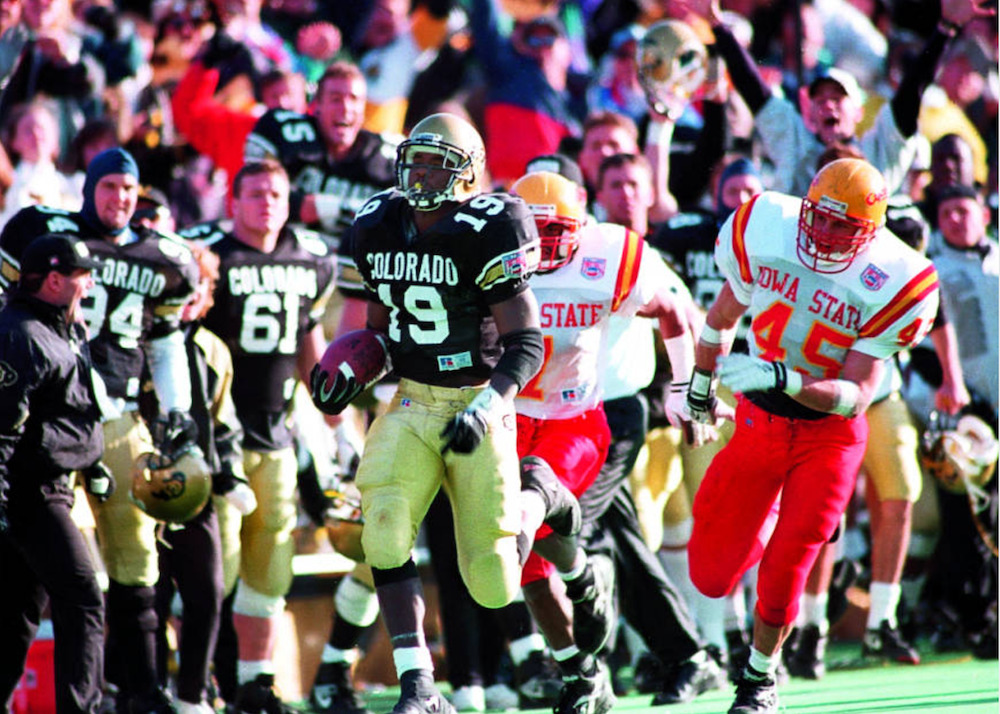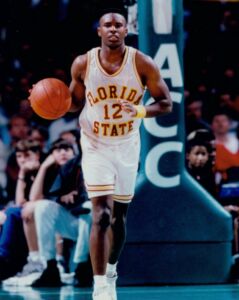
Mid-November Memories In Heisman History

There are plenty of November performances in Heisman history that seem to put a player over the top in the hive mind of Heisman voters.
And sometimes, there are just great moments for a player who was already on his way to the bronze statue. Other games are unique footnotes.
Colorado junior running back Rashaan Salaam was a leading favorite for the Heisman when he entered the Buffaloes’ 1994 regular season finale, a Nov. 19 home date against Iowa State.
Playing in near-freezing temperatures in Boulder, the No. 7 Buffs, at 9-1, were having a hard time heating up enough to put away the 0-9-1 visiting Cyclone team.
So they leaned on Salaam. The back had close to 200 yards through three quarters and was closing in on 2,000 for the season.
That’s when CU QB Kordell Stewart, early in the fourth quarter, handed the ball off to Salaam on a first down from the 33-yard line. The powerful back broke around right tackle and sprinted down the sideline, stampeding 67 yards for a game-sealing touchdown.
His final carry of the contest gave him 259 yards for the game (his second-most of the season) and 2,055 yards for the season. He finished as the nation’s leading rusher, scorer and all-purpose runner. Soon after, the Heisman was his.
But not all great performances end with happy endings. Mike Garrett, the 1965 winner from USC and the Trojans’ first Heisman winner, posted season-highs in rushing yards (210) and carries (40) against rival UCLA on Nov 20 at the L.A. Coliseum.
The Trojans built a 16-6 lead with just four minutes to play and a trip to the Rose Bowl seemed imminent. But the Bruins, led by future Heisman winner Gary Beban, roared back, taking advantage of first a USC fumble and then a recovered onside kick. Beban threw two late TD passes as UCLA won 20-16 to snatch a trip to Pasadena from the Trojans’ grasp.
USC Coach John McKay called the loss “the toughest defeat I’ve had to take by about 700 miles.” First-year UCLA Coach Tommy Prothro had high praise for Garrett, calling him “the best all-around back I’ve seen in college.”
Garrett was announced as the Heisman winner four days before USC’s season-finale victory over Wyoming in which Garrett posted his eighth 100-yard effort of the season, gaining 112 yards in a blowout win over the Cowboys with three rushing touchdowns.
Nine years prior, Notre Dame all-everything Paul Hornung was finishing off the most unique of Heisman seasons. No other player has ever won the Heisman on a losing team.
Despite his exemplary play, the Irish were in the midst of a miserable 2-8 season. When Nov. 17 rolled around, Notre Dame had but one win, an early season victory over Indiana that evened its record at 1-1.
Five losses followed (three to ranked teams), none by fewer than 13 points, but it wasn’t for a lack of Hornung’s efforts.
In his final home game, Hornung accounted for all 21 points in Notre Dame’s 21-14 win over North Carolina, scoring on three short touchdown runs and following each with an extra point kick. Playing with a bad thumb on the final drive, Hornung carried the load on the ground, crossing the goal line with 76 seconds left for the winning score.
Hornung finished the season with 917 passing yards, 420 rushing yards, three receptions, four punt returns and 496 yards on kickoff returns with a score. He also punted 33 times and had a pair of interceptions en route to the 1965 Heisman.
In 1986, Miami QB Vinny Testaverde entered the season as a strong Heisman favorite after finishing fifth in 1985. The top three finishers that year — Auburn winner Bo Jackson, Iowa’s Chuck Long and BYU’s Robbie Bosco — were outgoing seniors. In fact, only one other player among the 1985 Heisman Top 10 vote-getters — Michigan State RB Lorenzo White — returned in 1986.
The stage was Testaverde’s and he did not disappoint, leading the Hurricanes to an unbeaten regular season and a No. 1 ranking.
But Testaverde’s final college game, and his closing statement to Heisman voters, came one game earlier than anyone expected. He threw for 308 yards and two scores on Nov. 15, 1986, in a nondescript 23-10 win over Tulsa. That gave him 2,557 yards and 26 TDs on the year, plus four rushing scores.
But in an odd twist of fate, he missed his final regular-season game due to minor injuries suffered suffered from falling on his motor scooter days before a date with East Carolina.
Heisman voters, however, did not seem to mind. Testaverde won in a landslide with 2,213 total points, over 1,500 more than Temple second-place finisher Paul Palmer.




